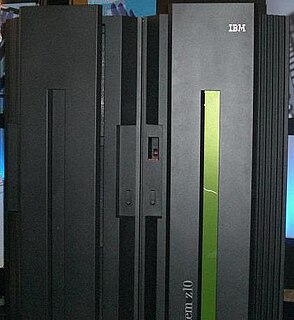The IBM RS64 is a family of microprocessors used in IBM's RS/6000 and AS/400 servers in the late 1990s.

The POWER5 is a microprocessor developed and fabricated by IBM. It is an improved version of the POWER4. The principal improvements are support for simultaneous multithreading (SMT) and an on-die memory controller. The POWER5 is a dual-core microprocessor, with each core supporting one physical thread and two logical threads, for a total of two physical threads and four logical threads.

The POWER6 is a microprocessor developed by IBM that implemented the Power ISA v.2.03. When it became available in systems in 2007, it succeeded the POWER5+ as IBM's flagship Power microprocessor. It is claimed to be part of the eCLipz project, said to have a goal of converging IBM's server hardware where practical.

IBM Z is a family name used by IBM for all of its z/Architecture mainframe computers.

The POWER2, originally named RIOS2, is a processor designed by IBM that implemented the POWER instruction set architecture. The POWER2 was the successor of the POWER1, debuting in September 1993 within IBM's RS/6000 systems. When introduced, the POWER2 was the fastest microprocessor, surpassing the Alpha 21064. When the Alpha 21064A was introduced in 1993, the POWER2 lost the lead and became second. IBM claimed that the performance for a 62.5 MHz POWER2 was 73.3 SPECint92 and 134.6 SPECfp92.

The history of general-purpose CPUs is a continuation of the earlier history of computing hardware.

IBM System z10 is a line of IBM mainframes. The z10 Enterprise Class (EC) was announced on February 26, 2008. On October 21, 2008, IBM announced the z10 Business Class (BC), a scaled-down version of the z10 EC. The System z10 represents the first model family powered by the z10 quad core processing engine. Its successors are the zEnterprise System models introduced in 2010 and 2012.
The SPARC64 V (Zeus) is a SPARC V9 microprocessor designed by Fujitsu. The SPARC64 V was the basis for a series of successive processors designed for servers, and later, supercomputers.
The IBM A2 is an open source massively multicore capable and multithreaded 64-bit Power ISA processor core designed by IBM using the Power ISA v.2.06 specification. Versions of processors based on the A2 core range from a 2.3 GHz version with 16 cores consuming 65 W to a less powerful, four core version, consuming 20 W at 1.4 GHz.
The z196 microprocessor is a chip made by IBM for their zEnterprise 196 and zEnterprise 114 mainframe computers, announced on July 22, 2010. The processor was developed over a three-year time span by IBM engineers from Poughkeepsie, New York; Austin, Texas; and Böblingen, Germany at a cost of US$1.5 billion. Manufactured at IBM's Fishkill, New York fabrication plant, the processor began shipping on September 10, 2010. IBM stated that it was the world's fastest microprocessor at the time.

POWER8 is a family of superscalar multi-core microprocessors based on the Power ISA, announced in August 2013 at the Hot Chips conference. The designs are available for licensing under the OpenPOWER Foundation, which is the first time for such availability of IBM's highest-end processors.
The zEC12 microprocessor is a chip made by IBM for their zEnterprise EC12 and zEnterprise BC12 mainframe computers, announced on August 28, 2012. It is manufactured at the East Fishkill, New York fabrication plant. The processor began shipping in the fall of 2012. IBM stated that it was the world's fastest microprocessor and is about 25% faster than its predecessor the z196.
IBM POWER is a reduced instruction set computer (RISC) instruction set architecture (ISA) developed by IBM. The name is an acronym for Performance Optimization With Enhanced RISC.
IBM Power microprocessors are designed and sold by IBM for servers and supercomputers. The name "POWER" was originally presented as an acronym for "Performance Optimization With Enhanced RISC". The Power line of microprocessors has been used in IBM's RS/6000, AS/400, pSeries, iSeries, System p, System i, and Power Systems lines of servers and supercomputers. They have also been used in data storage devices and workstations by IBM and by other server manufacturers like Bull and Hitachi.
The z13 is a microprocessor made by IBM for their z13 mainframe computers, announced on January 14, 2015. Manufactured at GlobalFoundries' East Fishkill, New York fabrication plant. IBM stated that it is the world's fastest microprocessor and is about 10% faster than its predecessor the zEC12 in general single-threaded computing, but significantly more when doing specialized tasks.

The IBM System/390 is the discontinued fifth generation of the System/360 instruction set architecture. The first ESA/390 computer was the Enterprise System/9000 (ES/9000) family, which were introduced in 1990. These were followed by the 9672 CMOS System/390 mainframe family in the mid-1990s. These systems followed the IBM 3090, with over a decade of follow-ons. The ESA/390 was succeeded by the 64-bit z/Architecture in 2000.
The z14 is a microprocessor made by IBM for their z14 mainframe computers, announced on July 17, 2017. Manufactured at GlobalFoundries' East Fishkill, New York fabrication plant. IBM stated that it is the world's fastest microprocessor by clock rate at 5.2 GHz, with a 10% increased performance per core and 30% for the whole chip compared to its predecessor the z13.
The z15 is a microprocessor made by IBM for their z15 mainframe computers, announced on September 12, 2019.
The Telum is a microprocessor made by IBM for their IBM Z mainframe computers, announced at the Hot Chips 2021 conference on August 23, 2021. Telum is IBM's first processor that contains on-chip acceleration for AI inferencing while a transaction is taking place. The first Telum-based system was the IBM z16, introduced in April 2022.








